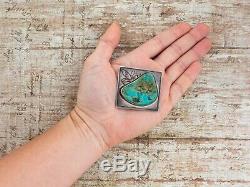
- Home
- Base Metal
- Closure
- Department
- Main Stone
- Agate (16)
- Black Onyx (15)
- Coral (154)
- Cowrie Shell (11)
- Jet (8)
- Kingman Turquoise (9)
- Lapis (13)
- Lapis Lazuli (16)
- Malachite (13)
- Mother Of Pearl (19)
- Multi-stone (208)
- Multicolored (39)
- Natural Turquoise (12)
- No Stone (274)
- Onyx (29)
- Opal (13)
- Petrified Wood (12)
- Shell (16)
- Spiny Oyster (13)
- Turquoise (2473)
- ... (2841)
- Metal
- Pendant Shape
Antique Vintage Sterling Silver Native Navajo Pawn Royston Turquoise Pin Brooch





We have similar Navajo and Turquoise items, which would pair nicely with this piece, for sale this week. Listing Description by: Cait P. Age Circa: Antique Native Navajo C. Markings: Unmarked, tested, and guaranteed.
Country of Origin: United States - Navajo Nation. Gram Weight: 22.1 grams. Color: opaque blue hue with brown spider-webbing. Stone Treatment: The stone(s) appear to be untreated, but we are not certified gemologists. Stone(s) have been tested and guaranteed using a professional Presidium Duo refractive, heat, and hardness tester.
Stone Cuts: Carved and polished cabochon. Pin/Brooch Style: Brooch, lapel pin, hat pin, scarf pin, tie pin. Closure Type: Pin stem with a locking "c" clasp. Convertible to Necklace Pendant: If desired, your local jeweler can add a bale to this piece so it can be worn as a pendant.
Handmade during the 1950s by a talented Navajo artisan. The body of the brooch is rectangular and adorned with a large Royston turquoise stone, which is blue with brown spider-webbing. Adorning the face of the brooch is a hand-stamped foliate motif. Completed with a pin stem with a locking "c" clasp, allowing it to be worn on a variety of accessories. Due to its size and weight, this piece is best suited for wear on thicker fabrics, such as those used in hats, scarves, and jacket lapels.
This listing is for the item only. This beautiful piece was made by a very talented Native American silversmith. It features handcrafted silversmith work throughout. Antique Native American jewelry is very rare to find.This is due to these pieces being made for reservation and personal use before the tourist trade became popular. Very few pieces were made and even less survived to today. The Navajo Nation sits on 27,000 square miles within the states of Arizona, New Mexico, and Utah.
The Navajo have a rich history and culture and have become known for creating some of the finest sterling silver and turquoise jewelry, incorporating their own traditional motifs with silversmithing. The squash blossom necklace is perhaps one of the most famous Navajo styles produced, along with turquoise inlay rings.
Turquoise is an important stone in Navajo culture; symbolizing happiness, good fortune, and good health. The first Navajo silversmith, Atsidi Sani, was taught around 1865 by a Mexican silversmith. Atsidi Sani in turn taught his four sons, who then started teaching other Navajo artisans. In the beginning, Navajo artisans created sterling silver jewelry for themselves and others in the Navajo Nation. The concept of Pawn, Old Pawn, and Dead Pawn Native American Jewelry came to be in the 1800s.
When a loan wasnt repaid, the item became known as either Old Pawn or Dead Pawn. Royston turquoise is a Nevada turquoise famous for being one of the few naturally green forms of turquoise in the world. It ranges in color from rich forest green and aqua blue offset by a heavy golden-brown matrix. Occasionally true-blue turquoise is found, along with spiderweb turquoise varieties.The item "Antique Vintage Sterling Silver Native Navajo Pawn Royston Turquoise Pin Brooch" is in sale since Sunday, March 29, 2020. This item is in the category "Jewelry & Watches\Ethnic, Regional & Tribal\Native American\Pins, Brooches". The seller is "abeautifultimeco" and is located in Fort Collins, Colorado. This item can be shipped to United States, Canada, United Kingdom, Denmark, Romania, Slovakia, Bulgaria, Czech republic, Finland, Hungary, Latvia, Lithuania, Malta, Estonia, Australia, Greece, Portugal, Cyprus, Slovenia, Japan, China, Sweden, South Korea, Indonesia, Taiwan, Thailand, Belgium, France, Hong Kong, Ireland, Netherlands, Poland, Spain, Italy, Germany, Austria, Bahamas, Israel, Mexico, New Zealand, Philippines, Singapore, Switzerland, Norway, Saudi arabia, United arab emirates, Qatar, Kuwait, Bahrain, Croatia, Malaysia, Chile, Costa rica, Aruba, Belize, Dominica, Grenada, Saint kitts and nevis, Turks and caicos islands, Bangladesh, Bermuda, Brunei darussalam, Bolivia, Egypt, French guiana, Guernsey, Gibraltar, Guadeloupe, Iceland, Jersey, Jordan, Cambodia, Liechtenstein, Luxembourg, Monaco, Macao, Martinique, Maldives, Nicaragua, Pakistan, Paraguay, Reunion, Uruguay, Russian federation.
- Country of Origin: United States - Navajo Nation
- Modified Item: No
- Country/Region of Manufacture: United States
- Metal Purity: .925
- Main Stone: Turquoise
- Metal: Sterling Silver
- Jewelry Type: Pins
- Tribal Affiliation: Navajo

